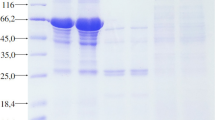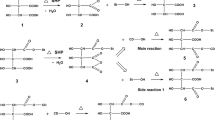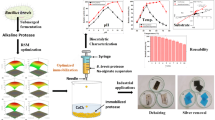Abstract
Calcium alginate–starch entrapped bitter gourd peroxidase has been employed for the treatment of a textile industrial effluent in batch as well as in continuous reactor. The textile effluent was recalcitrant to decolorization by bitter gourd peroxidase; thus, its decolorization was examined in the presence of a redox mediator, 1.0 mM 1-hydroxybenzotriazole. Immobilized enzyme exhibited same pH and temperature optima for effluent decolorization as attained by soluble enzyme. Immobilized enzyme could effectively remove more than 70% of effluent color in a stirred batch process after 3 h of incubation. Entrapped bitter gourd peroxidase retained 59% effluent decolorization reusability even after its tenth repeated use. The two-reactor system containing calcium alginate–starch entrapped enzyme retained more than 50% textile effluent decolorization efficiency even after 2 months of its operation. The absorption spectra of the treated effluent exhibited a marked difference in the absorption at various wavelengths as compared to untreated effluent. The use of a two-reactor system containing immobilized enzyme and an adsorbent will be significantly successful for treating industrial effluents at large scale, and it will help in getting water free from aromatic pollutants.







Similar content being viewed by others
Abbreviations
- BGP:
-
bitter gourd peroxidase
- Con A:
-
concanavalin A
- I-BGP:
-
immobilized peroxidase
- S-BGP:
-
soluble BGP
References
Zouari-Mechichi, H., Mechichi, T., Dhouib, A., Sayadi, S., Mart’ınez, T. A., & Mart’ınez, J. A. (2006). Enzyme and Microbial Technology, 39, 141–148. doi:10.1016/j.enzmictec.2005.11.027.
Papic, S., Koprivanac, N., Bozic, L. A., & Metes, A. (2004). Dye Pig, 62, 291–298. doi:10.1016/S0143-7208(03)00148-7.
Husain, Q. (2006). Critical Reviews in Biotechnology, 60, 201–221. doi:10.1080/07388550600969936.
Hai, I. F., Yamamoto, K., & Fukushi, K. (2007). Critical Reviews in Environmental Science and Technology, 37, 315–377. doi:10.1080/10643380601174723.
Zille, A., Tzanov, T., Gubitz, G. M., & Cavaco-Paulo, A. (2003). Biotechnology Letters, 25, 1473–1477. doi:10.1023/A:1025032323517.
Rojas-Melgarejo, F., & Rodriguez-Lopez, N. J. (2004). Process Biochem, 39, 1455–1464. doi:10.1016/S0032-9592(03)00276-0.
Akhtar, S., Khan, A. A., & Husain, Q. (2005a). Journal of Chemical Technology and Biotechnology (Oxford, Oxfordshire), 80, 198–205. doi:10.1002/jctb.1179.
Husain, M., & Husain, Q. (2008). Critical Reviews in Environmental Science and Technology, 38, 1–41. doi:10.1080/10643380701501213.
Lu, L., Zhao, M., & Wang, Y. (2007). World Journal of Microbiology & Biotechnology, 23, 159–166. doi:10.1007/s11274-006-9205-6.
Akhtar, S., Khan, A. A., & Husain, Q. (2005b). Bioresource Technology, 96, 1804–1811. doi:10.1016/j.biortech.2005.01.004.
Jan, U., Khan, A. A., & Husain, Q. (2006). World Journal of Microbiology & Biotechnology, 22, 1033–1039. doi:10.1007/s11274-005-3208-6.
Matto, M., & Husain, Q. (2006). Journal of Chemical Technology and Biotechnology (Oxford, Oxfordshire), 81, 1316–1323. doi:10.1002/jctb.1540.
Akhtar, S., Khan, A. A., & Husain, Q. (2005c). Chemosphere, 60, 291–301. doi:10.1016/j.chemosphere.2004.12.017.
Lowry, O. H., Rosebrough, N. J., Farr, A. L., & Randall, R. J. (1951). The Journal of Biological Chemistry, 193, 265–275.
Ramsay, A. J., & Goode, C. (2004). Biotechnology Letters, 26, 197–201. doi:10.1023/B:BILE.0000013711.32890.5d.
Akhtar, S., & Husain, Q. (2006). Chemosphere, 65, 1228–1235. doi:10.1016/j.chemosphere.2006.04.049.
Soares, G. M., De Amorim, M. T., & Costa-Ferreira, M. (2001). Journal of Biotechnology, 89, 123–129. doi:10.1016/S0168-1656(01)00302-9.
Fabbrini, M., Galli, C., & Gentili, P. (2002). Journal of Molecular Catalysis. B, Enzymatic, 16, 231–240. doi:10.1016/S1381-1177(01)00067-4.
Li, K. C., Xu, F., & Eriksson, K. E. L. (1999). Applied and Environmental Microbiology, 65, 2654–2560.
Kurniawati, S., & Nicell, A. J. (2007). Enzyme and Microbial Technology, 41, 353–361. doi:10.1016/j.enzmictec.2007.03.003.
Kulshrestha, Y., & Husain, Q. (2007). Toxicological and Environmental Chemistry, 89, 255–267. doi:10.1080/02772240601081692.
Mohan, S. V., Prasad, K. K., Rao, N. C., & Sarma, P. N. (2005). Chemosphere, 58, 1097–1105. doi:10.1016/j.chemosphere.2004.09.070.
Tonegawa, M., Dec, J., & Bollag, J. M. (2003). Journal of Environmental Quality, 32, 1222–1227.
Azni, I., & Katayon, S. (2003). The Environmentalist, 23, 329–334. doi:10.1023/B:ENVR.0000031411.87732.b1.
Tatsumi, K., Wada, S., & Ichikawa, H. (1996). Biotechnology and Bioengineering, 51, 126–130. doi:10.1002/(SICI)1097-0290(19960705)51:1<126::AID-BIT15>3.0.CO;2-O.
Bhunia, A., Durani, S., & Wangikar, P. P. (2001). Biotechnology and Bioengineering, 72, 562–567. doi:10.1002/1097-0290(20010305)72:5<:562::AID-BIT1020>3.0.CO;2-S.
Matto, M., & Husain, Q. (2007). Chemosphere, 69, 338–345. doi:10.1016/j.chemosphere.2007.03.069.
Acknowledgements
University Grants Commission and Department of Science and Technology, New Delhi, Government of India is gratefully acknowledged for providing special grants to the Department in the form of DRS and FIST.
Author information
Authors and Affiliations
Corresponding author
Rights and permissions
About this article
Cite this article
Matto, M., Satar, R. & Husain, Q. Application of Calcium Alginate–Starch Entrapped Bitter Gourd (Momordica charantia) Peroxidase for the Removal of Colored Compounds from a Textile Effluent in Batch as well as in Continuous Reactor. Appl Biochem Biotechnol 158, 512–523 (2009). https://doi.org/10.1007/s12010-008-8396-8
Received:
Accepted:
Published:
Issue Date:
DOI: https://doi.org/10.1007/s12010-008-8396-8




